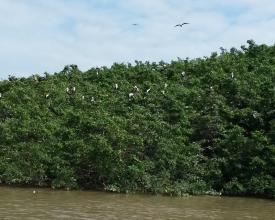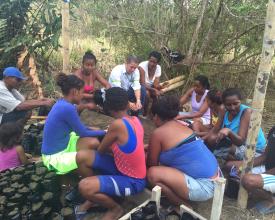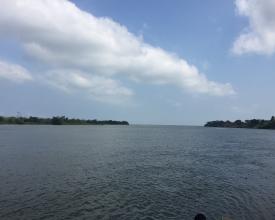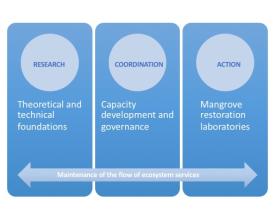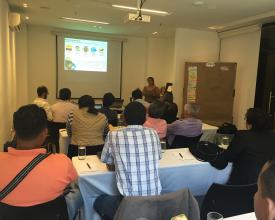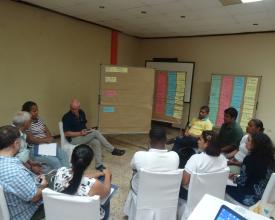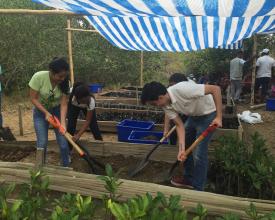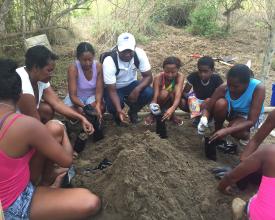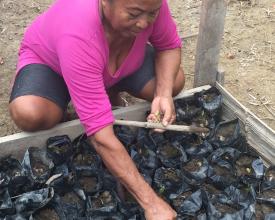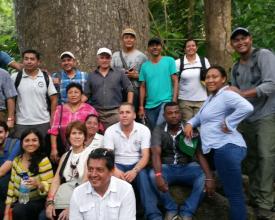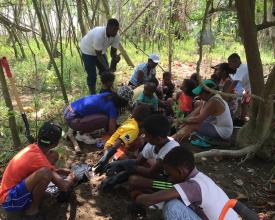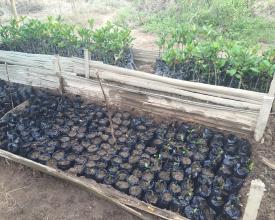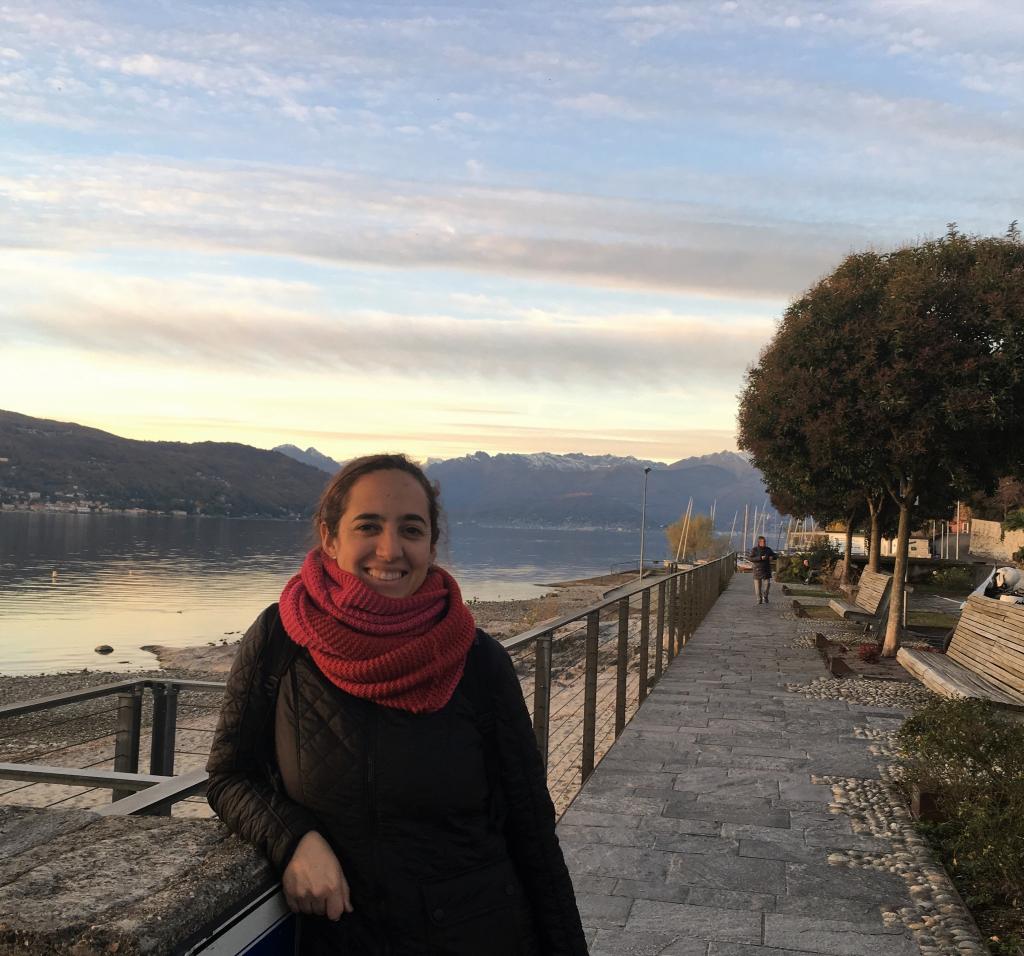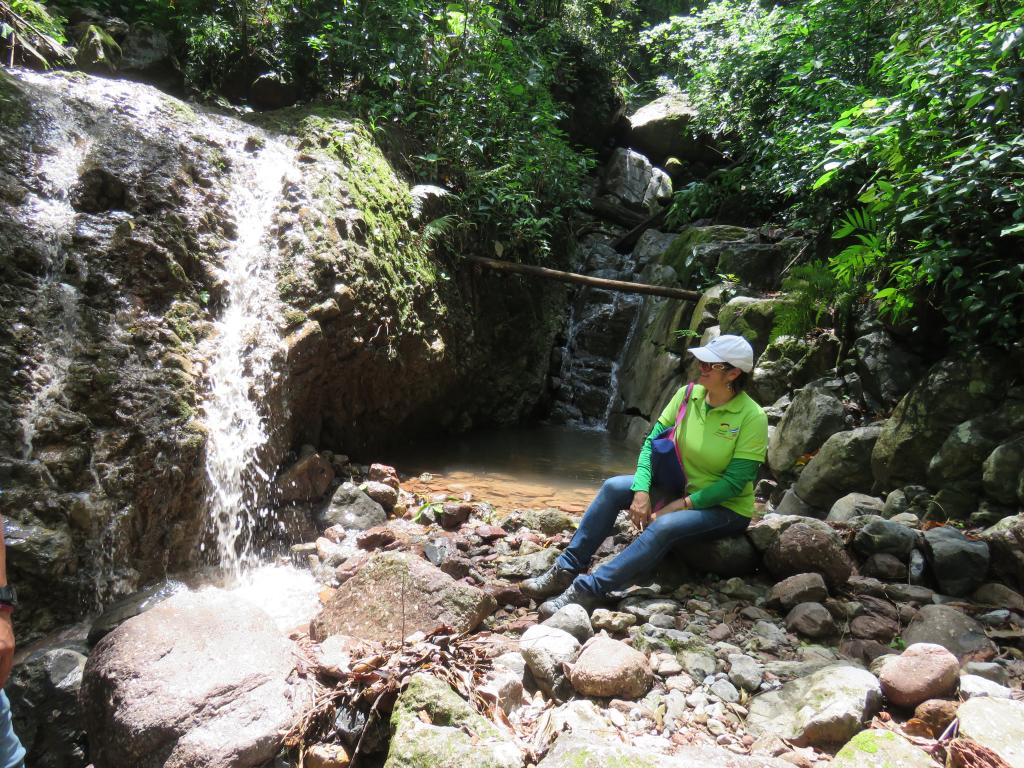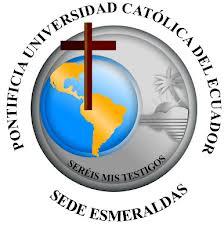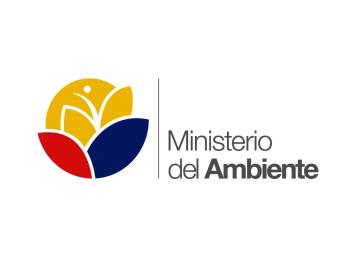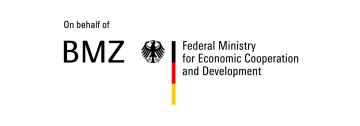
Restauration des mangroves au "Refugio de Vida Silvestre Manglares Estuario Río Esmeraldas".
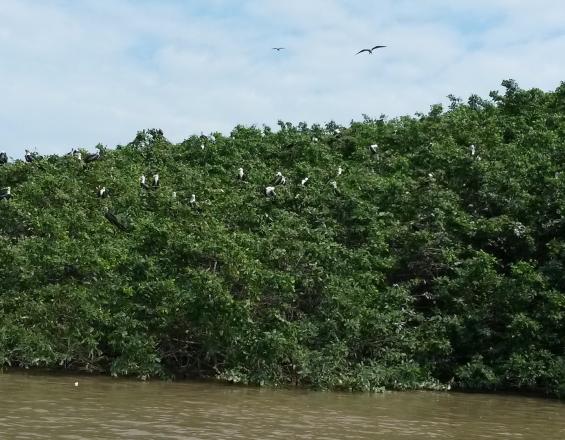
Les mangroves de l'estuaire du Rio Esmeraldas ont une grande valeur écologique, économique et sociale en raison de leurs utilisations directes et indirectes. Elles constituent un atout important pour l'adaptation au changement climatique de la population locale. Cet écosystème est menacé par l'expansion de la ville d'Esmeraldas et des zones agricoles et aquacoles (notamment l'élevage de Pacu à ventre rouge). Plusieurs organisations locales et nationales ont uni leurs forces pour la restauration de l'écosystème et la gestion efficace de la zone protégée.
Contexte
Défis à relever
- Le processus de restauration est long et relativement coûteux. En outre, la plupart des bénéfices se manifesteront à moyen et/ou long terme.
- La production de cachama est très rentable. L'activité aquacole a un impact direct sur les eaux estuariennes (contamination de l'eau due à l'utilisation massive d'antibiotiques).
- Malgré les progrès de la coopération inter-agences dans l'estuaire du Rio Esmeraldas, les sources de rejet des eaux usées de la ville d'Esmeraldas n'ont pas encore été éliminées.
- Une meilleure articulation est nécessaire par le biais d'accords entre les institutions publiques, communautaires et privées, permettant la génération, la diffusion et l'utilisation de l'information.
- La zone d'intervention ne dispose pas d'un espace de gouvernance établi nécessaire pour articuler les actions dans l'écosystème.
- Le processus de développement des capacités des communautés nécessite des ressources techniques et financières à moyen et long terme.
Emplacement
Traiter
Résumé du processus
Les trois blocs se renforcent mutuellement et se complètent. Le bloc I (Recherche : fondements théoriques et techniques) constitue la base de l'information et de la connaissance et établit le lien entre la science et la pratique. Le bloc II (Coordination : développement des capacités et gouvernance) est l'élément central de l'initiative. Il favorise une meilleure articulation des parties prenantes et des institutions et le renforcement des capacités locales de gestion des mangroves, contribuant ainsi à la durabilité de l'initiative. Dans le bloc III (Action : laboratoires de restauration de la mangrove), les impacts des deux autres blocs convergent et se manifestent dans des actions concrètes qui prétendent être l'impulsion pour l'adoption de l'approche de restauration et de gestion durable de l'écosystème de la mangrove à Esmeraldas.
Blocs de construction
La recherche : Fondements théoriques et techniques
Les activités qui font partie de ce bloc de construction visent à améliorer les connaissances sur l'écosystème des mangroves, les impacts du changement climatique et la base théorique et technique de la restauration des mangroves. Il s'agit d'articuler la compilation d'informations scientifiques avec les connaissances locales, en transférant les résultats dans une approche pratique.
- La préparation du plan de lutte contre le changement climatique du gouvernement municipal d'Esmeraldas a été soutenue en tant qu'étape préliminaire à la mise en œuvre de la mesure.
- En 2016, un dialogue a été organisé entre des experts et des techniciens d'Équateur et d'autres pays afin de mieux comprendre les impacts du changement climatique sur l'écosystème de la mangrove et de partager les expériences et les leçons tirées de la restauration de la mangrove. Ces connaissances sont utilisées pour planifier la reproduction de la mangrove rouge (Rhizophora harrisonii), le reboisement in situ et le suivi (voir également le bloc III).
- Un accord a été conclu avec la Pontificia Universidad Católica (bureau d'Esmeraldas) afin de contrôler l'efficacité des essais et de mener des recherches sur les écosystèmes de mangrove liés au changement climatique.
Facteurs favorables
- Intérêt politique et technique du gouvernement municipal d'Esmeraldas pour la création d'un plan de lutte contre le changement climatique.
- Prédisposition de l'académie à collaborer à la mise en œuvre de la recherche pratique.
- Intérêt des différents acteurs pour l'échange d'expériences et de leçons tirées de la gestion des mangroves.
Leçon apprise
- La recherche sur le changement climatique, pour être pertinente et applicable à la résolution des problèmes et défis de la conservation et de la gestion durable des mangroves, doit être planifiée entre tous les acteurs de la société (MAE et GIZ 2016).
- Les études de vulnérabilité devraient inclure les perceptions des communautés locales.
- La diffusion de l'information doit s'adresser à tous les niveaux politiques et décisionnels, aux communautés, aux fonctionnaires et autres, en utilisant tous les moyens possibles (pas seulement numériques) de manière large et créative.
- Le développement de processus de formation sur le changement climatique devrait être une ligne d'action pour les années à venir (MAE et GIZ 2016).
Coordination : Développement des capacités et gouvernance
Cette approche modulaire se traduit par diverses activités allant de mesures de formation à des espaces d'échange et de dialogue entre les parties prenantes et entre les institutions, en passant par le soutien à l'élaboration d'accords. Un exemple est l'accord entre le ministère de l'environnement, l'unité de gestion de la zone protégée et l'université en ce qui concerne le suivi et l'évaluation participatifs des pépinières et des essais de restauration. Le renforcement du comité de gestion de la zone protégée est une autre mesure clé qui vise à améliorer la gouvernance de la zone.
En outre, l'appropriation et l'intégration de la politique nationale de changement climatique dans les actions de niveau intermédiaire, telles que le développement de plans de changement climatique, la mise en œuvre de mesures d'adaptation dans les secteurs productifs et dans la gestion des écosystèmes, sont reflétées.
Facteurs favorables
-
Volonté et confiance des parties prenantes pour coopérer et partager les responsabilités.
-
Articulation et mise en œuvre d'une politique publique en matière de climat au niveau local.
Leçon apprise
- Des espaces de dialogue larges et participatifs sont essentiels pour parvenir à des accords durables avec les populations et les acteurs locaux, lorsqu'il y a une réelle participation à la prise de décision (MAE et GIZ 2016).
- La mise en place d'espaces de gouvernance locale (par exemple, un comité de gestion des aires protégées) facilite la conception, la mise en œuvre et l'appropriation d'actions d'adaptation basées sur les écosystèmes.
- L'amélioration de la coordination entre les différentes institutions étatiques qui ont juridiction sur la zone à partir de leurs domaines de compétence permettra une gestion durable et intégrale de l'aire protégée de la mangrove située dans le périmètre urbain (MAE et GIZ 2016).
Action : Laboratoires de restauration de la mangrove
La stratégie sous-jacente de ce bloc de construction consiste, au lieu de poursuivre des objectifs quantitatifs de zones restaurées, à commencer par de petites actions concrètes telles que des pépinières de graines de mangrove et des essais sur le terrain avec les communautés. Cela permet de réduire les obstacles et d'obtenir des résultats tangibles et immédiats. Associée à l'élaboration et à la diffusion de supports d'information et à un suivi participatif, elle permet de présenter la restauration des mangroves comme un moyen d'adaptation au changement climatique pour les acteurs locaux. En outre, elle renforce les capacités des parties prenantes et des institutions locales et génère des synergies (voir le bloc II).
Facteurs favorables
-
Collaboration étroite avec les parties prenantes locales et conseils continus.
-
Renforcement des capacités des communautés à maintenir l'écosystème et à améliorer la fourniture de services écosystémiques importants pour leurs moyens de subsistance.
Leçon apprise
- Si les résultats en termes de superficie restaurée sont encore limités, les investissements dans le développement des capacités et la gouvernance de la zone devraient avoir des effets sociaux, écologiques et économiques à moyen et long terme.
- Pour la restauration de la mangrove, la zone devrait être zonée en fonction de critères sociaux et environnementaux : 1) les zones prioritaires où le reboisement doit être initié immédiatement ; 2) les zones où d'autres types d'interventions doivent être menées avant le reboisement (comme le dragage, la sensibilisation et la formation des populations locales environnantes, l'élimination des rejets d'eaux usées) ; et 3) d'autres zones où la mangrove peut être laissée à elle-même pour se rétablir (MAE et GIZ 2016).
Impacts
- La nécessité de produire des informations locales pertinentes et actualisées qui répondent aux besoins de la gestion durable des mangroves, y compris les impacts du changement climatique, est largement reconnue par toutes les parties prenantes.
- Les espaces d'information et de dialogue ont favorisé la coordination des actions de gestion dans la zone.
- À ce jour, une pépinière a été créée et une zone d'environ deux hectares de l'écosystème de mangrove a été restaurée.
- Les communautés ont renforcé leur compréhension des impacts du changement climatique sur l'écosystème et des liens avec leurs moyens de subsistance.
Bénéficiaires
- Direct : Communauté de Pianguapi
- Indirect : Ministère de l'environnement, gouvernement municipal autonome décentralisé d'Esmeraldas, gouvernement provincial autonome décentralisé d'Esmeraldas
Objectifs de développement durable
Histoire
Les mangroves du Refugio de Vida Silvestre Manglares Estuario Río Esmeraldas (refuge de vie sauvage de l'estuaire des mangroves de la rivière Esmeraldas) ont une grande valeur écologique, économique et sociale en raison de leurs utilisations directes et indirectes. Cet écosystème fournit de la nourriture, génère des emplois dans le secteur de la pêche et des fruits de mer, protège le littoral, séquestre et stocke le carbone et offre également des possibilités de loisirs.
Dans le contexte du changement climatique, il constitue un atout très important pour la population locale. Les communautés, les gouvernements municipal et provincial d'Esmeraldas et le ministère de l'environnement, conseillés par la GIZ, mettent en œuvre des mesures d'adaptation au changement climatique axées sur la restauration de l'écosystème de la mangrove, dans le but commun de préserver ce trésor naturel.
Le territoire de la zone protégée comprend les mangroves qui existent à l'embouchure de la rivière Esmeraldas et une zone adjacente avec des parcelles de broussailles sèches. Malheureusement, ces mangroves sont menacées par l'expansion de la ville d'Esmeraldas et des zones agricoles et aquacoles (en particulier l'élevage de Pacu à ventre rouge).
Parallèlement, le changement climatique se traduit par une augmentation de la température qui affecte le comportement reproductif et la répartition des espèces de la flore et de la faune. Les précipitations extrêmes ont un impact sur les palétuviers (défoliation) et facilitent l'entrée d'eau douce dans les mangroves. Les changements dans le degré de salinité de l'eau et l'élévation du niveau de la mer affectent les espèces vivant dans l'écosystème.
Afin d'inverser ces tendances négatives, les communautés participent à des activités de restauration, soutiennent le maintien d'une pépinière et facilitent la mise en place d'essais sur l'écosystème de la mangrove, entre autres. Ces activités ont été conçues sur la base d'une analyse de la vulnérabilité (combinant des informations scientifiques et des méthodes participatives) et ont été classées par ordre de priorité dans le plan de lutte contre le changement climatique du gouvernement municipal d'Esmeraldas.
Les premiers résultats montrent que les activités contribuent à accroître la résilience de l'écosystème de la mangrove et, partant, des communautés. En outre, les actions conjointes favorisent l'articulation des acteurs publics et privés, ce qui contribue à une gestion efficace de la zone protégée.
Ce processus de rétablissement de la mangrove est censé être le point de départ d'une gestion durable de la zone et garantit le flux des bénéfices de la mangrove pour les communautés et l'économie de la région.

